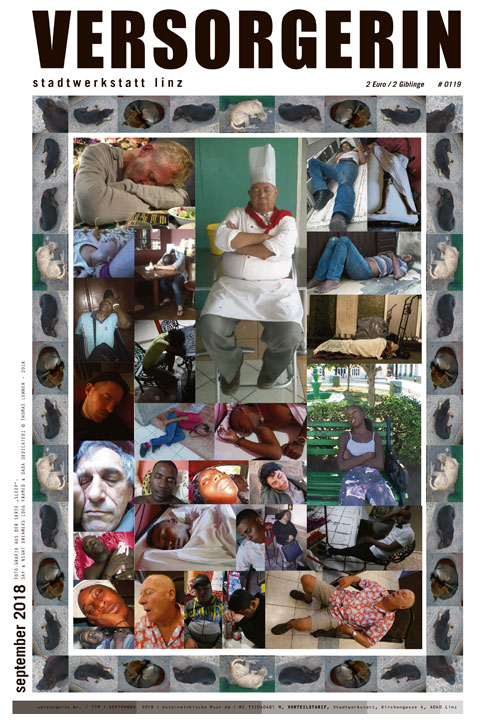Like a fatigued, transparent giant bird with wide, slackened wings the monumental sleep house1 »SONnaia SONata« (Sonata of Sleep) conceptualised by the important avant-garde architect of the post-revolutionary period Konstantin Melnikov (1890-1974) seems to have landed as an idea for a »green city«. Melnikov‘s project was meant to be a contribution to a contest for a town of recreation near Moscow for nearly 100.000 workers in 1929. In Melnikov‘s blueprint 12 identical sleep houses encircled the center of the orbital ideal city that stood in a close relationship to nature and that carried vast green areas.
The »Green City« was conceptualised alongside the first five-year plan in 1928 which aimed at a radical enhancement of industrial and agricultural production in the Soviet Union and brought upon heavy demands to the working class. According to the doctine of the time, economic goals could only be reached via collective effort and the optimisation of collective effort. The individual had to be subsumed to the collective and to become a part in a gigantic machinery, in which the production process was to dominate over all other areas of life. The demarcation between man and machine under the slogan of a »New (Soviet) Man« was not meant to be negated but nevertheless was put into question.
Melnikov‘s concept for a sleep house shall be taken as illustrative for elementary considerations and ideas connected to the phenomenon of sleep in modernity. As it becomes clear, sleep and its function for both the individual and society comes in many ways with problematic and contradicting connotations.
In our understanding, going to sleep is a very individualistic, intimate act. For many of us the period of sleep is the only period of the day without social interaction, although also in this respect the boundary between sleep and waking state is becoming fuzzy via the use of virtual media. Regardless of the positive experience it brings about, sleep is seen as something contradictory: phenomenologically, there is some similarity to death, during sleep we apparently lose control, our senses do not work or only in a limited way. As the outside plays only a limited role, sleep is an arena of an autonomous soul and its functionality which is highly individualistic. The spectrum of sleep ranges from everyday‘s experience to absurd and surreal moments. The same applies for the imaginary spaces that provide the framework for our dreams. Unlike any other phenomenon, dream represents a soul-like interior largely independent from any exterior. The spaces (bedrooms) we provide for sleep are our most private and intimate as well.
Seemingly free from intention, sleep is seen as antithesis to the active waking state and its potentials. Up to the beginning of industrialisation the natural day and night rythm determined the phases of sleep and waking state. In the 19th century upheaval set in due to different factors, most prevalent the use of artificial light. Artifical light made the environment (most notably the city) secure at any daytime and opened access to various nocturnal pleasures. The illuminated factory hall made night shifts possible. The dream of capitalists seemed to have come true: a more efficient and permanent use of the means of production. Only man himself remained stubborn, as human workers were in need of sleep. Hence scientists in the second half of the 19th century aimed at negating the necessity for sleep or at reducing it. The desire for sleep for the bourgeois or intellectual individual, by contrast, was not contested as those groups of people were seen to work in an actually (intellectually) demanding way, opposed to the monotonous work of the industrial proletariat. The brain needed relaxation and recovery, the hands and muscles did not.
Not least the industry and the military were dreaming at the beginning of modernity (and, actually, up to now) of an optimised man, who hardly needs rest and can be more effectively used in production or battle. Concepts that also can be found in contemporary ideology of liberalised and excessive production of goods, services and creativity itself.
Nevertheless it did not work to marginalise or prevent sleep. Unbearable sleep conditions had been amongst the precarious life conditions of the proletariat that were so negative that, over time, they endangered the productivity of the worker in the long run. This was to be contrasted with improvement of the living conditions concerning hygiene and social circumstances, which also included hygiene of sleep. After 1900 the reduction of sleep had not been so prevalent anymore, tackling sleep disorders became more important. Either way, it was also not a philanthropic motive that triggered it but the desire to maintain physiological and psychological effectiveness. Statistics of health insurances gave a perfect illustration of that.
Melnikov again: The architect was a huge admirer of sleep. To him, sleep was an elementary prerequisite to life, like eating or breathing. The bedroom in his famous house in Moscow is among the modern icons of its category. The privacy celebrated in there however found its radical antithesis in the blueprint for the »Green City« – which longed for nothing less than the complete collectivisation and control over sleep in order to take control over sleep‘s individual, unconscious and anarchic character. In the obstinacy of sleep there obviously was a danger to the Soviet society.
Melnikov‘s »SONnaia SONata« was not meant to be a sleep house in the traditional sense, it rather resembled a huge laboratory of sleep. To a central transparent entrance tract designed to prepare for sleep the sleep tracts, two-storeyed and with a slight declenion to the outside, were attached. Also the sleep tracts were meant to be fully transparent. Sleep was meant to take place during the whole day, in different shifts. Large windows not only established a connection to the natural universe, they also expressed that sleep wasn‘t meant to be private any longer. People should be able to sleep during all times of the day. The collective rythm of sleep should therefore become independent from daytime, which would have greatly expanded possibilities to employ productive labour. According to scientific positions of his time, Melnikov supposed that the rythm of sleep was solely a matter of convention and could be altered. The exclusion of the night as the habitual time of sleep illustrates, more than anything else, how far Melnikov‘s ideas of influencing people and transforming them into a »free« man – free from traditions – could go. Little emphasis however was placed upon reflections upon the consequences for the individual. In the final consequence and taken to its radical extreme, a seperation between a »day society« and a »night society« would have been the result, as otherwise the social integration of the individual would have been impossible.
The spatial and atmospheric conditions (temperature, atmospheric humidity, light, sound, etc.) in the sleep tracts were equal for all sleepers and were made uniform via technical and acoustic installations. Responsible for that were technicians and medical doctors who controlled the setting from semicircular control rooms (as the only rooms intransparent to the outside). Inspired by scientific theses from his period Melnikov assumed that messages and texts transmitted during sleep could be of great influence. Music and sounds from nature (lapping of water, the voice of the wind, noises of leaves, singing of birds, etc.) aimed at a quick relaxation and a more effective sleep with a shorter duration than that of natural sleep. Light and sound were maximal opposites to the visual and acoustic reality in the factories.
The slight declension of the tracts guaranteed an optimal position for sleep on loungers that had similarities with laboratory benches and that could be put into a slow motion in order to fasten and improve sleep. Blankets were not part of the concept. Maybe because blankets would have provided an overly distinct refuge for the individual, a refuge too personal and protective. All bodies were meant to be exposed to the transparent collective space that surrounded them.
The logical opposite to Melnikov‘s sleep hotel was the center of the »Green City«. Here he conceptualised a monumental »Institute for the Transformation of the Human Form« in which, amidst a plethora of offerings and events, the indoctrination of humans in their waking state was supposed to have happened.
Melnikov‘s »Green City« remained a concept. The main focus of the critics was the profound misunderstanding that, in a time devoted to massive enhancement of productivity, Melnikov would glorify sleep and provide a heroic architecture. These critics failed to notice how much and how radical Melnikov wanted to de-individualise sleep and to surrender it to mania of productiveness in a collective society. At any rate, sleep occupies a third of a human‘s lifetime, hence, within any totalitarian society a long, unchecked period of individual states of the mind, from which »evil« ideas could emerge.
Translation: Philip Hautmann


